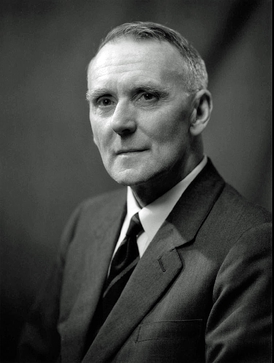J. A. Ratcliffe facts for kids
Quick facts for kids
John Ashworth Ratcliffe
|
|
|---|---|

John Ashworth Ratcliffe, FRS
© National Portrait Gallery, London |
|
| Born | 12 December 1902 Bacup, England
|
| Died | 25 October 1987 (aged 84) Cambridge, England
|
| Alma mater | Sidney Sussex College, Cambridge |
| Known for | Ionospheric physics |
| Spouse(s) | Nora Disley |
| Children | 2 |
| Awards | See list |
| Scientific career | |
| Fields | Radio physics |
| Institutions | University of Cambridge TRE in Dundee Radio Research Station |
| Academic advisors | Edward Appleton |
| Doctoral students | Basil Briggs Maurice Wilkes Joseph Lade Pawsey Ronald N. Bracewell Henry G. Booker |
| Other notable students | Martin Ryle |
John Ashworth Ratcliffe was an important British scientist. He was a radio physicist, which means he studied how radio waves travel. People often called him "Jar." He was born in 1902 and passed away in 1987. His work helped us understand how radio signals reach us from far away.
Contents
John Ratcliffe's Early Life
John Ashworth Ratcliffe was born in Bacup, England, on December 12, 1902. He was the older son of Harry Heys Ratcliffe. His mother was Beatrice Alice.
He went to several schools as he grew up. These included Bacup and Rawtenstall Secondary School and Giggleswick School. In 1921, he went to Sidney Sussex College, Cambridge. He studied natural sciences and finished with top honors in 1924.
Studying Radio Waves
After college, John Ratcliffe started doing research. He worked with another scientist named Edward Appleton. They studied how radio waves travel through the air. They wanted to know why radio signals sometimes got weaker or disappeared at night. This is called 'fading'.
In 1927, Ratcliffe became the head of a research group. This group studied the ionosphere. The ionosphere is a special layer in the Earth's upper atmosphere. It has electrically charged particles. Radio waves bounce off this layer, which helps them travel long distances. Ratcliffe's group learned a lot about how this layer works.
Helping During World War II
When World War II began in 1939, John Ratcliffe used his knowledge to help. He worked on radar systems. Radar uses radio waves to detect objects like airplanes. Britain had a network of radar stations called Chain Home. These stations protected the country's coasts.
Ratcliffe was sent to work at the Telecommunications Research Establishment (TRE). He helped develop a new type of radar. It was called Chain Home Low (CHL). This system could find aircraft flying at lower heights. His work during the war took him to different places in the UK.
After the War
After the war ended, Ratcliffe returned to University of Cambridge. His research group grew bigger. Some scientists from the TRE joined him. They started studying radio signals coming from the sun.
One of his students, Martin Ryle, led a new section. This section focused on radio astronomy. This field studies objects in space by looking at the radio waves they give off.
In 1960, John Ratcliffe left Cambridge. He became the director of the Radio Research Station. He worked there until 1966.
Later Life and Family
John Ratcliffe married Nora Disley in 1930. They had two daughters, Margaret and Elizabeth. Sadly, Elizabeth passed away in 1966, and Nora died in 1977.
John Ashworth Ratcliffe passed away at his home in Cambridge on October 25, 1987.
Awards and Recognition
John Ratcliffe received many awards for his important work. Here are some of them:
- 1946 Awarded OBE
- 1951 Became a Fellow of the Royal Society
- 1953 Invited to give the Royal Institution Christmas Lectures on The Uses of Radio Waves
- 1958 President of the Physical Society
- 1959 Awarded CBE
- 1962 Became an Honorary Fellow of Sidney Sussex College, Cambridge
- 1965 Appointed CB
- 1966 Received the Royal Medal from the Royal Society
- 1966 President of the IEE
- 1966 Received the Faraday Medal
- 1976 Received the Gold Medal from the Royal Astronomical Society
- 1979 Awarded an honorary DSc degree from the University of Kent

